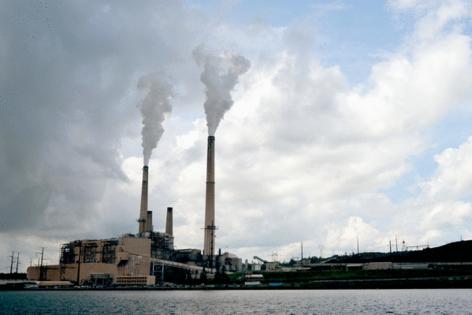Are EVs really better for the environment? Study checks role of coal, battery and range
Published in Business News
Electric vehicles in the United States produce fewer greenhouse gases than gas automobiles, even when factoring in battery-making emissions, limited range during bad weather and coal-fired power grids, according to a new analysis.
The University of Michigan study, published in an American Chemical Society journal, compared projected lifetime emissions of battery, hybrid and gas-powered vehicles from the 2025 model year. On average, gas-powered vehicles will produce 70% more greenhouse gases than EVs with 300-mile charging ranges.
The data include emissions from battery and auto production, a roughly 200,000-mile vehicle lifespan and final recycling or other disposal of the vehicle. Data show EVs create less pollution than plug-in hybrids and other hybrids; plug-in hybrids are more environmentally friendly than other hybrids; hybrids create less pollution than gas-powered vehicles; and smaller vehicles of any powertrain are less emission-intensive than SUVs and pickups.
Pickups, SUVs, sedans and other vehicles used for personal transportation make up roughly 16% of greenhouse gas emissions in the United States, according to the study, and individuals' vehicle choices "will play a significant role" in reducing pollutants.
"Yes, there are differences in terms of how much benefit but again, we want to make it clear that our study shows advantages everywhere in the country," said Greg Keoleian, a study author and co-director of the University of Michigan's Center for Sustainable Systems, "which demonstrates that consumers everywhere in the country play a key role in addressing climate pollution and in lowering climate pollution."
The adoption challenge
Widespread EV adoption lags in the United States, where battery-powered models make up roughly 8% of the market share and account for at most about 5% of vehicles in use. Analysts expect a surge in sales through the end of September, when legislation signed by President Donald Trump will end $7,500 tax credits for buyers and lessees. After that, automakers are bracing for a steep drop-off in sales, at least temporarily.
While many auto industry analysts and insiders still have faith battery-powered automobiles will dominate sometime in the future, the short-term fate of electrification has been shaken by "openly antagonistic" policies enacted under Trump, said Sam Abuelsamid, vice president of market research at auto communications firm Telemetry.
Most recently, Trump's administration announced plans to scrap federal rules on vehicle tailpipe emissions, which have been a driving force in pressuring automakers to electrify their fleets.
"Clean energy incentives, tax credits, and regulations enacted during the previous administration were designed to build a new landscape for American manufacturing by fostering technological advances and encouraging domestic manufacturing," U.S. Rep. Debbie Dingell, D-Ann Arbor, said in a statement.
"They worked, and led to a surge in EV investments, driving sales, lowering costs for consumers, and creating thousands of good-paying union jobs. The rollback of these incentives and regulations reverses all that progress and puts us on a dangerous path."
Buyer concerns about high sticker prices, limited access to quick charging, and anxiety about how far an EV will go before its battery needs a boost have also limited sales growth.
U.S. Rep. Tim Walberg, R-Tipton, said in a statement that forcing automakers to electrify faster than market demand is not a viable policy: “While I am not against EVs or reducing transportation emissions, we must not implement misguided regulations that limit consumer choice or exacerbate the pollution they are trying to address.
"Even after the Biden-Harris administration’s Green New Deal giveaways and costly regulations, electric vehicles continued to sit unpurchased on auto dealership lots due to a lack of consumer demand," Walberg added. "Government mandates that force the mass production of EVs, only for them to sit idly on lots, don’t help with emissions reductions — they make it worse."Even without government pressure or incentives, Abuelsamid said, the industry will move toward electrification.
"People are not going to stop buying EVs just because Trump says they're bad," he said. "Manufacturers, despite slowing some product rollout, are still producing EVs and are going to continue producing EVs."
Still, recent developments demonstrate the industry's slow and uneven march toward electrification. Last month, Ford Motor Co. said it would invest $2 billion at its Louisville Assembly Plant to build a $30,000 electric midsize pickup while delaying the start of production at a Tennessee battery plant until 2027. And this week, General Motors Co. said it would temporarily reduce planned production of EVs at plants in Kansas and Tennessee because of soft demand.
'Overwhelming' benefit
A University of Michigan-made calculator based on the study's data allows users to compare greenhouse gas emissions between two vehicles on a county-by-county basis. The local power supply matters. Fossil fuels such as natural gas and oil, among the top power sources in Michigan, create more pollution. Wind, hydroelectric, solar and nuclear power are considered cleaner.
But overall, driving an EV is still greener, even in coal-heavy areas.
"Study after study has shown that driving an electric vehicle, no matter the electricity grid mix, is significantly cleaner than a gasoline vehicle," Kathy Harris, Natural Resources Defense Council director for clean vehicles, said in a statement. "And, unlike other cars, electric vehicles actually get cleaner over time — as the dirtiest sources of electricity retire and new, clean energy gets hooked up to the grid. A cleaner grid means a cleaner EV."
Driving an EV sedan in some counties in hydroelectric-powered Oregon could mean a roughly 90% cut in emissions compared to a gas-powered SUV, according to an example from the study. In coal-powered Appalachian counties, EV sedans are still expected to produce 60% less in greenhouse gases than traditional gas-powered SUVs.
While EVs do not produce tailpipe emissions when driven, making the batteries is emissions-intensive. But those emissions pale in comparison to pollution caused by gas-powered vehicles on the road, according to the data.
"We acknowledge there are tradeoffs," Keoleian said. "But the overall benefit is overwhelming."
Previous research based on 2020 model-year vehicles estimated that driving certain gas vehicles was better for the environment in about 1-2% of U.S. counties, considering the local power grid.
The University of Michigan research is based on the assumption that, over time, the U.S. power grid will increasingly rely on renewable energy sources rather than fossil fuels. Keoleian said utilities already are planning on increased demand from EV charging and are adjusting to provide more power.
"When you actually look at total life cycle emissions for vehicle manufacturing and production and then energy used through vehicle lifetime and end-of-use processing of vehicles through recycling and disposal, EVs always come out ahead," Abuelsamid said. "Every single time."
©2025 www.detroitnews.com. Visit at detroitnews.com. Distributed by Tribune Content Agency, LLC.












Comments